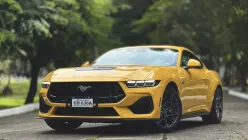With the launch of the seventh-generation Mustang, Ford has ushered in what it claims is the most powerful iteration of the nameplate yet. In fact, the new Mustang’s Dark Horse trim level has been tasked to power the Blue Oval brand’s planned efforts in motorsports.
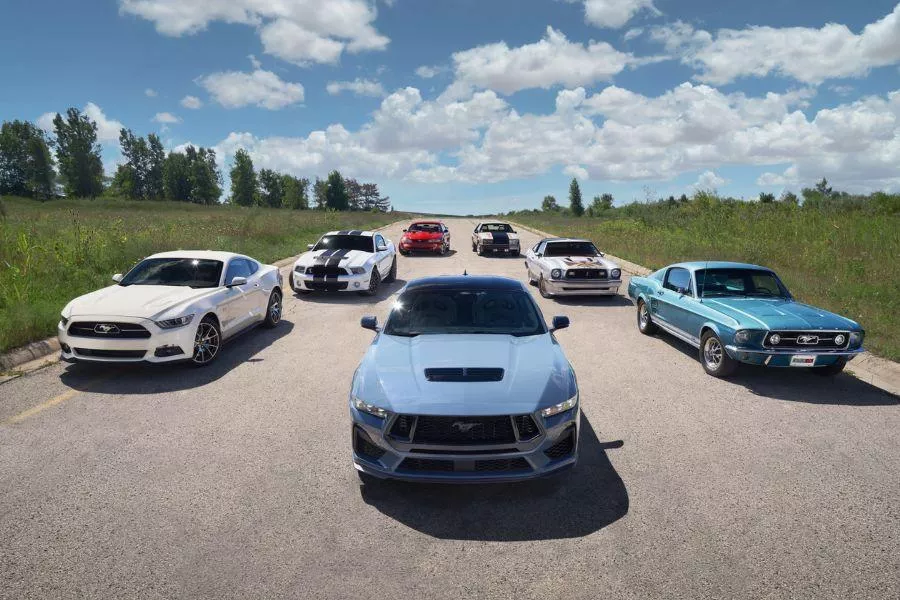
Ford's iconic pony car has been in continuous production for almost six decades
But in order to appreciate how far the iconic pony car has come, we’ll need to take a look at the Mustang’s roots. Although it was the namesake of the pony car class, the Mustang wasn’t the first of its kind; that distinction belonged to the Plymouth Barracuda which went on sale just two weeks prior to the Mustang’s reveal.
However, the Barracuda’s flaws were a result of Chrysler’s limited finances at the time, and it died after three generations in 1974. As it stands, the Mustang is practically the most enduring pony car of all time.
First-generation Ford Mustang (1965-1973)
The Ford Mustang was born into the world on April 17, 1964, for the 1965 model year. It started as a project for a personal luxury coupe, bearing the codename ‘Allegro.’ Two body styles were developed in the form of a coupe and convertible.
At its launch, the car already featured what would be hallmarks of the segment, with a long hood, short deck, round headlamps, two doors, and rear-wheel-drive. Air intakes just before the rear wheels helped cool the drum brakes, and the rear had taillamps shaped as three vertical bars.
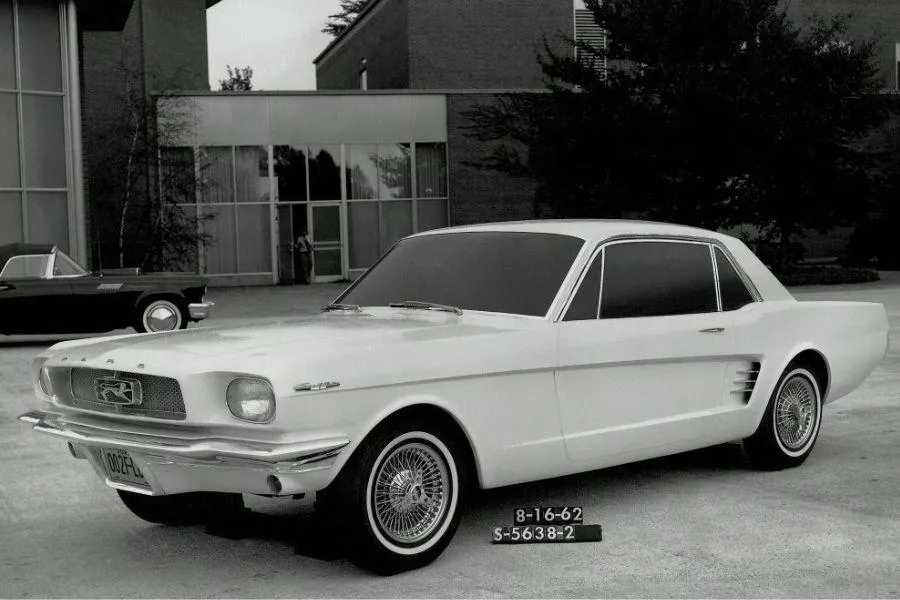
First-generation Ford Mustang
Two bucket seats were the extent of cabin accommodations, with the instrument cluster comprising a linear speedometer between two round dials. A 1965 redesign resulted in the now trademark fastback body style, featuring a sloped rear window and thick B-pillars. Ford added two rear seats which were largely vestigial due to the cramped space.
For propulsion, the Mustang relied on a 2.8-liter inline-6 that made just 100 horsepower and 212 Nm of torque, mated to a 3-speed manual transmission. Eventually, the lineup was bolstered with nine V8 choices, including 6.4- and 7.0-liter versions for performance variants by 1973. The most potent of these was a big-block V8 that put down 406 horsepower and 624 Nm of torque, mated to a 4-speed manual.
Second-generation Ford Mustang (1974-1978)
The Mustang’s second iteration or Mustang II came on the cusp of an oil embargo stemming from the 1973 oil crisis. As the first-generation model’s size grew during its later years, customers shifted to lower-priced and fuel-efficient alternatives, including Ford’s own Maverick compact car.
Ford designed the Mustang II to be lighter and shorter than the first generation, using a unibody platform derived from the Ford Pinto subcompact model. The second-gen Mustang came as a two-door notchback coupe and three-door hatchback with 2+2 seating, featuring a folding rear seat.
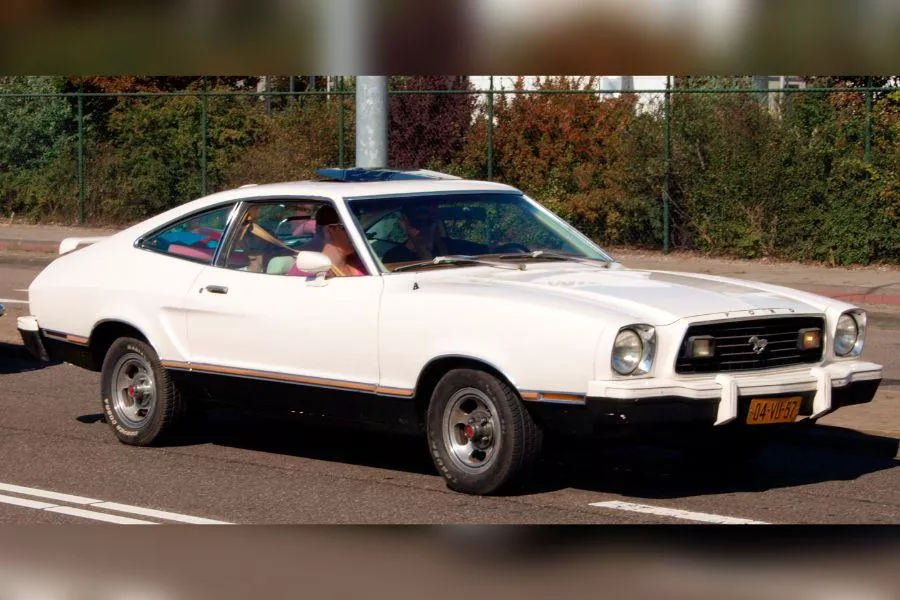
Second-generation Ford Mustang
The Mustang’s return to a smaller size meant it can use thriftier engines, ranging from a 2.3-liter inline-4 to a 2.8-liter V6. Improvements were made to its handling characteristics, being the first American car to offer power-assisted rack-and-pinion steering. It won Motor Trend’s Car of The Year honors in 1974, enjoying brisk sales to become the sixth best-selling Mustang of all time.
With the oil crisis fading by 1975, Ford decided to put in a 4.9-liter V8 in the Mustang to restore its performance image, rated at 140 horsepower. Opera windows and a padded vinyl half-top were added for the luxury-oriented Ghia. This was followed by Stallion and Cobra II appearance packages in 1976, the latter being popular with customers for the black grille, front and rear spoilers, dual racing stripes., and Cobra badging.
The ‘King Cobra’ limited edition version became available in 1978, featuring a deep air dam, stripes, and a Pontiac Trans Am-style cobra hood decal.
Third-generation Ford Mustang (1979-1993)
For 1979, the third Mustang iteration was based on the Fox platform, giving rise to the ‘Fox body Mustang’ moniker. It shared the platform with the prior Ford Fairmont and Mercury Zephyr in an effort to keep development and construction costs at a minimum.
The Cobra appearance package persisted until 1982, when it was replaced by the Mustang GT after a 13-year absence. Available body styles comprised a hatchback, convertible, coupe, and notchback. Two front end styles were offered, depending on the model year; one featured front headlamps and an angled back front clip, while the other had flush composite headlamps accompanied by an aero-style front clip.

Third-generation Ford Mustang [Image: Auto Evolution]
By 1983, a restyled fascia with a more rounded nose and reshaped grille became standard, with wider taillamps replacing the vertical units. A convertible body style was added, and the Mustang for this model year become the first to use the Ford Blue Oval emblem. From 1984 to 1986, Ford sold the Mustang SVO (Special Vehicle Operations), a limited-run model that offered four-wheel disc brakes, 16-inch alloys, and an SVO-specific bi-plane spoiler.
Engines spanned from a 2.3-liter inline-4 (both naturally aspirated and turbocharged) to a 4.9-liter small-block V8 (advertised as a 5.0-liter). Transmission choices included a 4- or 5-speed manual and a 3- or 4-speed automatic. As a result of low sales in the mid-1980s, Ford toyed with the idea of replacing the rear-wheel Mustang with a front-wheel-drive version adapted from the Mazda MX-6. Mustang fans pushed back, resulting in Ford retaining the rear-wheel drivetrain and going for a major facelift instead.
Fourth-generation Ford Mustang (1994-2004)
Ford introduced the fourth-generation Mustang in November 1993, its first major redesign in 15 years. This was the final generation underpinned by the Fox platform, featuring some stylistic elements taken from previous Mustangs. While the convertible was still offered, the notchback and hatchback styles were replaced by a more standard coupe design.
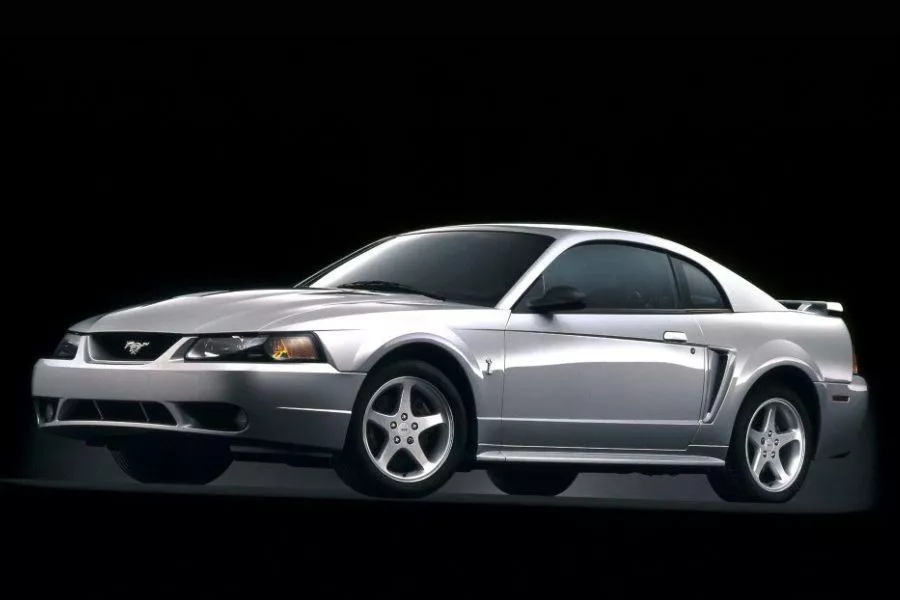
Fourth-generation Ford Mustang
The automaker invested $700 million (over Php 40.1 million in today’s currency) to update the Fox platform, including improvements to the car’s handling and noise, vibration, and harshness (NVH) levels compared to the previous Mustang. A new dual-cockpit layout was adopted, with power windows, remote keyless entry, and cruise control among the preferred equipment features.
Reintroduced in January 1994 was the GT trim level, featuring improved performance and handling. Available engines for this generation included a 3.8-liter V6, a 4.9-liter small-block V8, and a 5.8-liter Windsor V8. All of them worked with either a 5-speed manual or 5-speed automatic gearbox. Three-point seatbelts and dual front airbags became part of standard safety equipment.
Fifth-generation Ford Mustang (2005-2014)
The fifth-generation Mustang was previewed by two pre-production concept cars that debuted at the 2003 North American International Auto Show. This was based on the new D2C platform, with styling cues reminiscent of late 1960s Mustang fastback models.
Optional equipment on the previous fourth-generation model became standard offerings on the fifth generation, such as dual power mirrors, power door locks, AM/FM stereo with CD player, and larger disc brakes. Several new options were offered, such as a DVD-based GPS navigation system, heated seats, HID headlamps, ambient interior lighting, and a glass roof.
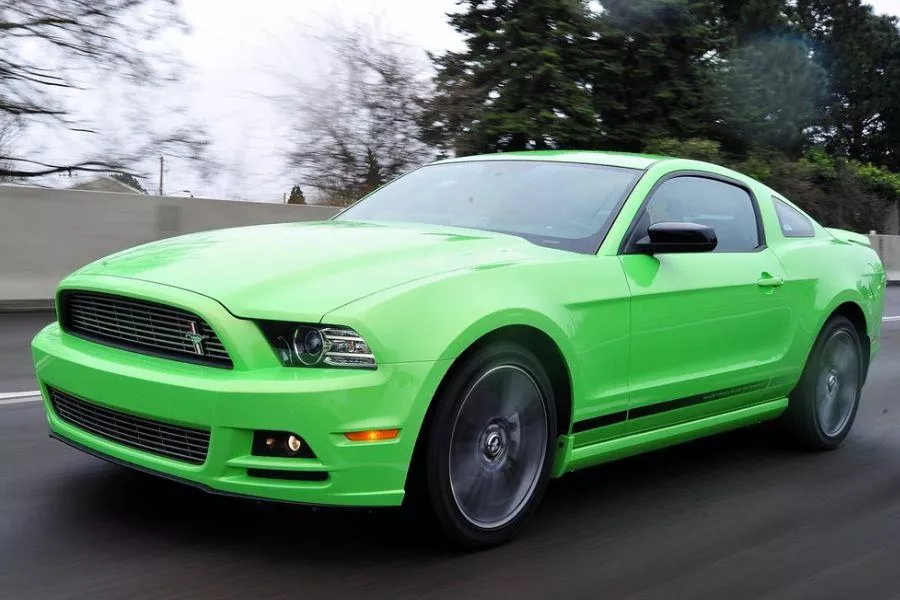
Fifth-generation Ford Mustang
Available engines included a 4.0-liter Cologne V6 that made 160 hp and 305 Nm of torque, all the way to a 5.8-liter Modular supercharged V8 that reached a top speed in excess of 322 kilometers per hour. Power would be sent to the rear wheels through either a manual or automatic transmission, both with five or six forward gears.
Probably the most significant characteristic of this generation is the use of a new three-link live rear axle with Panhard rod, which sacrificed handling but reduced cost as well as wear and tear. Reacting to media criticism over its decision to use a live axle setup, Ford said that an independent rear suspension would have made the fifth-generation Mustang’s showroom price more expensive by $5,000 (Php 287,000).
The 2010 model update was the first to be sold in Japan without the requisite conversion to right-hand drive, but with modifications to the exterior lighting in compliance with Japanese regulations.
Sixth-generation Ford Mustang (2015-Present)
This is the Mustang’s current form, unveiled in December 2013. The model came with a wider body and lowered stance compared to the previous Mustang. Ford managed to increase interior passenger volume to almost 2,400 liters while retaining the 2,720mm wheelbase.
The fifth-generation Mustang is the first to be marketed and sold globally, with both left-hand and right-hand-drive models assembled at Ford’s Flat Rock Assembly Plant in Michigan. Depending on the market, the Mustang is available with either a 2.3-liter EcoBoost inline-4, a 3.7-liter V6, or a 5.0-liter Coyote V8.
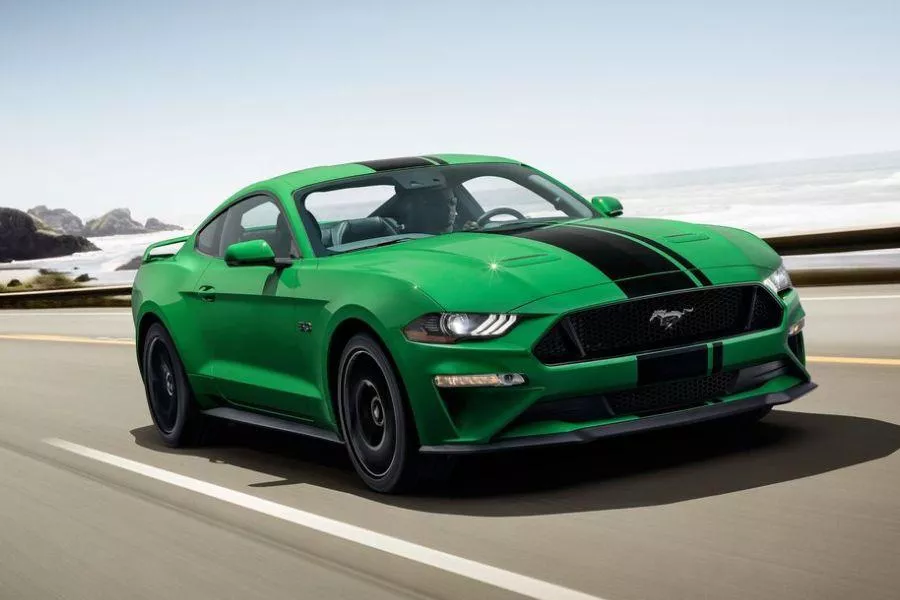
Sixth-generation Ford Mustang
Performance variants carried either a Voodoo or Predator engine, both V8s that displace 5.2 liters. Transmission options are a 6-speed manual, 6-speed automatic, and 10-speed automatic gearboxes. A new independent rear suspension was developed for this release.
In February 2015, the Mustang earned five stars from the National Highway Traffic Safety Administration (NHTSA) for front, side, and rollover crash protection. Four months later, a total of one million Mustang units were recalled over defective airbags made by Takata Corporation.
The GT500 performance model was re-introduced in 2020, followed by the return of the Mach 1 in 2021 after a 17-year pause.
Seventh-generation Ford Mustang (2024)
Ford recently unveiled the seventh-generation Mustang slated for the 2024 model year. This is built on the S650 platform, an evolved version of the S550 used by the current Mustang, available in both coupe and convertible designs.
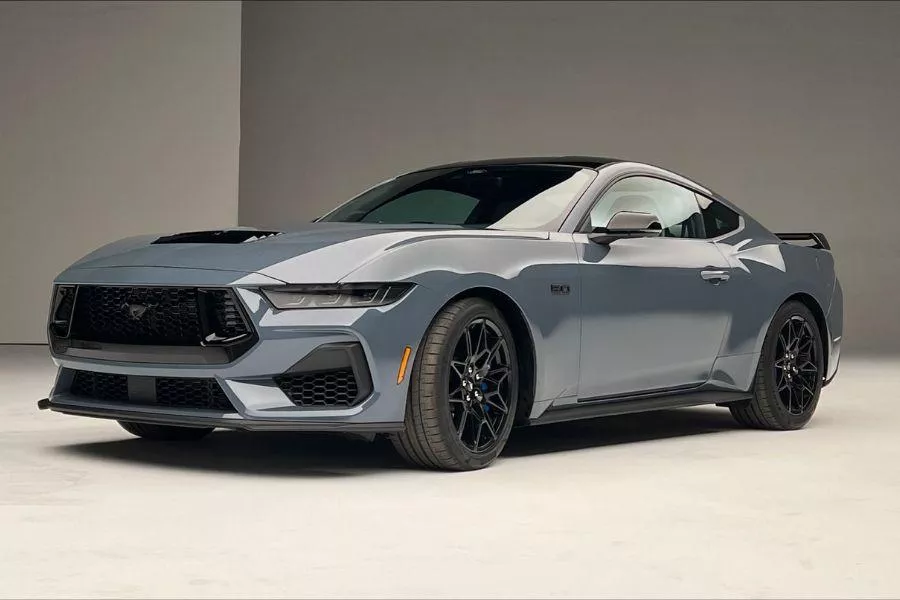
Seventh-generation Ford Mustang
While the exterior echoes design cues from past generations of Mustangs, the interior has been radically redesigned. Facing the driver are no longer the familiar analog gauges, as these are now simulated on a 12.4-inch fully digital instrument cluster physically linked to a 13.2-inch touchscreen.
It features tweaked versions of the 2.3-liter EcoBoost and 5.0-liter Coyote V8 engine, the latter rated at 480 horsepower. These are mated to either a 6-speed manual transmission or a 10-speed automatic with paddle shifters. For performance enhancements, the latest Mustang comes with a segment-first electronic drift brake that takes advantage of the car’s rear-wheel drivetrain.
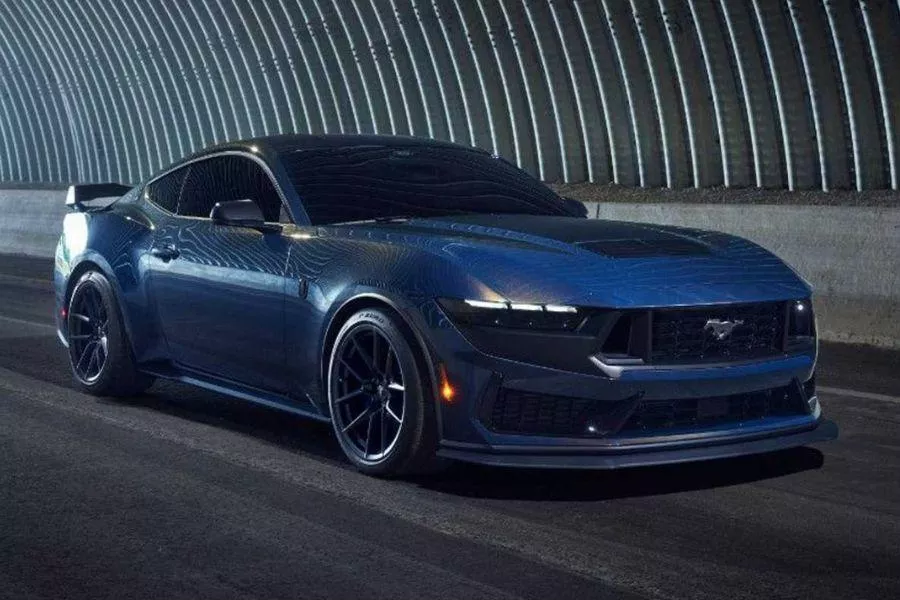
2024 Ford Mustang Dark Horse
An even more extreme version of the seventh-generation Mustang is the Dark Horse performance model, targeting 500 horsepower from its 5.0-liter V8 engine. Ford says that the Mustang Dark Horse will lead its motorsports efforts.
Read more about how your favorite automotive nameplates evolved at Philkotse.com.
Know more about Ford Mustang 2026

Arguably the most popular vehicle from the Blue Oval company, the Ford Mustang is one powerful coupe that is competing in the market with its sixth-gen model. Ford Mustang 2025 price Philippines from Php 3,499,000 to Php 3,999,000, depending on the variants. Speaking of variants, the Mustang comes with four variants in the Philippines, namely the 2.3L EcoBoost, 5.0L GT Fastback, 5.0L GT Convertible, and Shelby GT500. The base Mustang uses a 2.3-liter EcoBoost inline-4 engine that makes 310 hp and 475 Nm of torque, while the GT variants are powered by a 5.0-liter Ti-VCT V8 engine that generates 460 hp and 569 Nm of torque.
In terms of dimensions, this American sports car has a length of 4,788 mm, a width of 2,081 mm, and a height of 1,395 mm. Additionally, it comes with a wheelbase length of 2,721 mm and a ground clearance rated of 137 mm. The Mustang is competing in the local market against the likes of the Chevrolet Camaro, Dodge Challenger, and Nissan 370Z.
>>> New and used Ford Mustang 2025 for sale in the Philippines
Ford Mustang Launch
The Ford Mustang Philippines has been around since the 1960's. Since then, the Ford-produced pony car has been through six generations which have been sold in numerous countries around the world. It wasn't until 2015 that the Mustang entered the Philippine market.
For 2018, Ford then gave the pony car an update. This one made its debut at the 2018 Manila International Auto Show, and it received a new convertible variant, a new exhaust system, as well as a magnaride suspension system.
ALL-NEW, NEXT-GEN Ford Mustang in the Philippines | Philkotse Quick Look
Ford Mustang Exterior
The Philippine-spec Mustang can either come in a fastback configuration or a convertible configuration. Common among these two different layouts are a wide, aggressive grille, a long hood, and the three-bar taillights. Speaking of lights, this pony car from the Blue Oval is also equipped with LED headlamps, LED turn signal lamps, as well as a front fog lamp. For wheels, all variants of the model ride on a set of 19-inch alloy wheels.
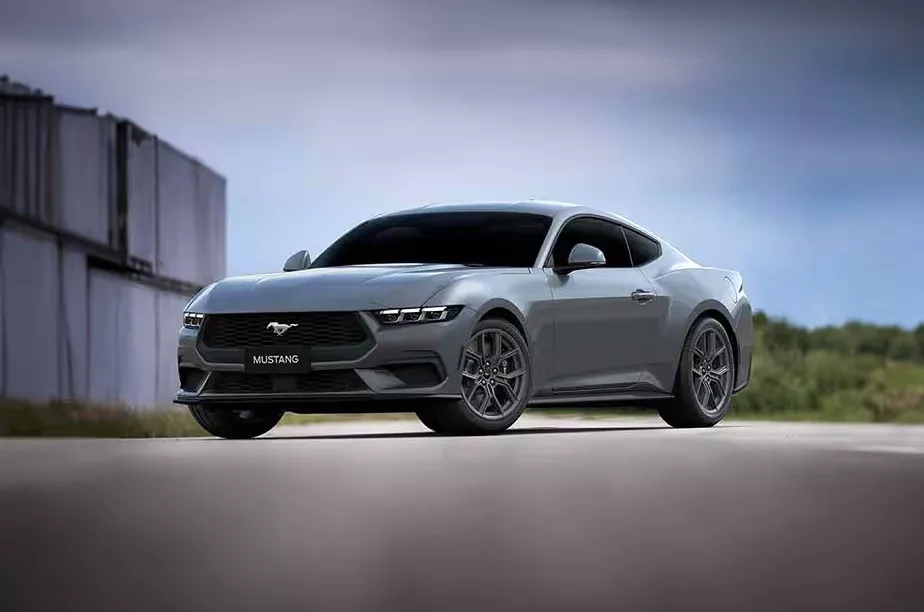

Common among these two different layouts are a wide, aggressive grille, a long hood, and the three-bar taillights.
The Ford Mustang has six available color options. This includes Magnetic Metallic, Competition Orange, Red Race, Oxford White, Black, and Tripple Yellow Tri-Coat.
Ford Mustang Interior
Inside, the Mustang for the Philippine market gets a well-arranged, premium interior made out of a combination of sturdy plastic, leather, and metal. Soft-touch surfaces are abundant, which include the touch points on the interior door cards, on the elbow rests, steering wheel, and on key spots on the dashboard.
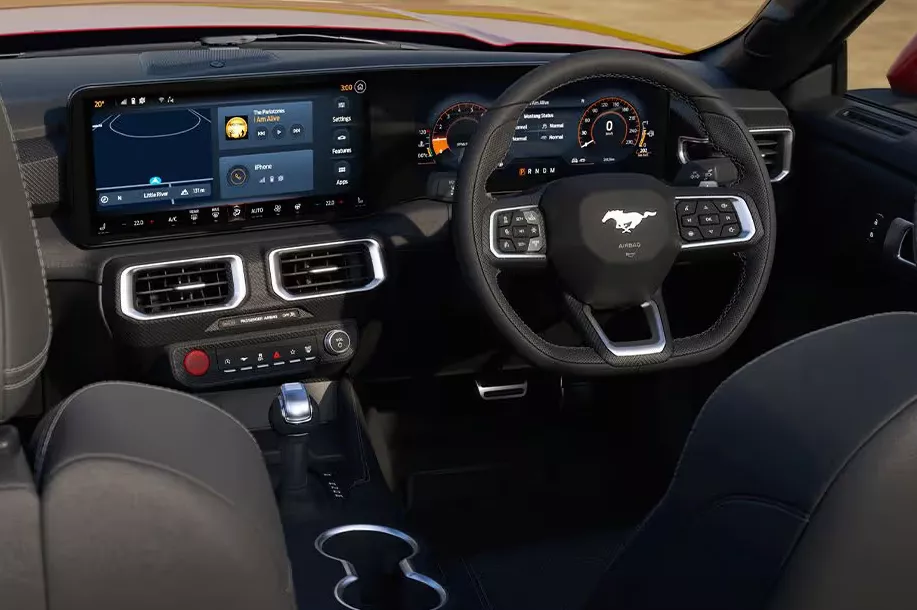
Inside, the Mustang for the Philippine market gets a well-arranged, premium interior.
For seating, its four occupants make use of leather-wrapped seats and are kept comfortable by a dual-zone automatic climate control system. The driver is then provided a multi-function steering wheel with tilt and telescopic adjustability, a push-to-start button, and a digital gauge cluster. The driver's seat on all Mustang variants can also be adjusted electronically.
Technology & Safety Features
To handle entertainment, the Ford Mustang for the Philippine market is equipped with an eight-inch touchscreen capable of connecting via Ford's Sync 3 software. It also has Bluetooth connectivity, USB ports, and an aux-in port. The said infotainment system is linked to a 12-piece Shaker Pro audio system.
For ease of use, the Ford sports car comes standard with adaptive cruise control, a rearview parking camera, parking sensors, a hill-start assist, rain-sensing wipers, automatic headlamps, and an auto-dimming rearview mirror.
For the EcoBoost variant, safety is handled by seven airbags. The GT variants on the other hand get five airbags. The entire variant lineup however, comes standard with anti-lock braking with electronic brake-force distribution, stability and traction control, lane departure warning, lane keep assist, blind spot monitoring, a tire pressure monitor, a car alarm and engine immobilizer, and ISOFIX child seat tethers.
Platform & Chassis
The American coupe uses Ford's S550 platform, but like all the models that came before, it retains the front-engine, rear-wheel-drive layout. For suspensions, this Ford model uses a McPherson Strut for the front and a fully independent rear suspension. Braking is handled by disc brakes all around, and all trims of this car use a hand-operated manual parking brake.
In terms of dimensions, the Mustang Philippines is 4,788mm long, 2081mm wide, and 1,395mm in height. Its wheelbase has a length of 2,721mm, and it has a ground clearance of 137mm.
Ford Mustang Engine & Drivetrain
The Philippine-market Mustang has two engine options. The smaller one is the 2.3-liter EcoBoost inline-4 gasoline engine. At most, this four-banger can produce up to 310 horsepower and 475 Nm of torque. The GT variants get the larger, 5.0-liter V8 gasoline Coyote engine, which can make up to 460 horsepower and 569 Nm of torque. The only variant that gets a six-speed manual transmission is the Mustang GT 5.0 Premium Convertible MT. The rest are equipped with a ten-speed automatic gearbox with paddle shifters.
Available colors for the Ford Mustang Philippines are Shadow Black, Iconic Silver Metallic, Oxford White, Race Red Metallic, Velocity Blue Metallic, Carbonized Gray Metallic, Twister Orange Metallic Tri-Coat, Antimatter Blue Metallic, Grabber Yellow, and Rapid Red Metallic.
In comparison to rivals such as the Dodge Challenger 2025 and Chevrolet Camaro that offer one engine only in the local market, the Ford Mustang can be considered as one of the most versatile sports cars thanks to its price and engine options.
Ford Mustang 2025 Price List
Let's check out the Ford Mustang 2025 price in the Philippines.
| Variants | Price |
|---|---|
| Ford Mustang 2.3 EcoBoost Premium AT Fastback | ₱3,499,000 |
| Ford Mustang 5.0 V8 GT Premium AT Fastback | ₱3,999,000 |
Ford Mustang Pros & Cons
Pros
- Offers different engine options
- Rich history
- Distinctive sports car design
Cons
- Lack of manual option in PH-spec Mustang
- Tight second-row seats
- No AWD
Ford Mustang FAQs
1. What type of wheel drive is the Ford Mustang 2025?
The Ford Mustang 2025 is a rear wheel drive car.
2. How much is the Ford Mustang 2025 in the Philippines?
The price of the Ford Mustang 2025 ranges from P3,499,000 to P3,999,000, depending on the variant.
3. Is the Ford Mustang a 4-seater?
Yes, all of the Mustang variants come with 4 seat configuration.
4. What are the dimensions of the Ford Mustang 2025?
The Mustang 2025 dimensions are 4,788mm long, 2,081mm wide and 1,395mm in height.
5. How many colors is the Ford Mustang 2025 available?
The Ford Mustang 2025 is available in Grabber Blue, Atlas Blue, Rapid Red, Eruption Green, Shadow Black, Dark Matter Gray, Iconic Silver, Carbonized Gray, Mischievous Purple, Race Red, and Oxford White.
₱ 3,048,000 - ₱ 7,760,000
ExploreRecent posts
- Fold Mustang old vs new Sep 16, 2022
- ford mustang dark horse trim launched Sep 16, 2022
- 2024 ford mustang revealed Sep 19, 2022






